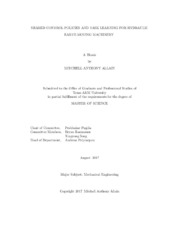| dc.description.abstract | This thesis develops a shared control design framework for improving operator efficiency and performance on hydraulic excavation tasks. The framework is based on blended shared control (BSC), a technique whereby the operator’s command input is continually augmented by an assistive controller. Designing a BSC control scheme is subdivided here into four key components. Task learning utilizes nonparametric inverse reinforcement learning to identify the underlying goal structure of a task as a sequence of subgoals directly from the demonstration data of an experienced operator.
These subgoals may be distinct points in the actuator space or distributions overthe space, from which the operator draws a subgoal location during the task. The remaining three steps are executed on-line during each update of the BSC controller. In real-time, the subgoal prediction step involves utilizing the subgoal decomposition from the learning process in order to predict the current subgoal of the operator.
Novel deterministic and probabilistic prediction methods are developed and evaluated for their ease of implementation and performance against manually labeled trial data. The control generation component involves computing polynomial trajectories to the predicted subgoal location or mean of the subgoal distribution, and computing a control input which tracks those trajectories. Finally, the blending law synthesizes both inputs through a weighted averaging of the human and control input, using a blending parameter which can be static or dynamic. In the latter case, mapping probabilistic quantities such as the maximum a posteriori probability or statistical entropy to the value of the dynamic blending parameter may yield a more intelligent control assistance, scaling the intervention according to the confidence of the prediction.
A reduced-scale (1/12) fully hydraulic excavator model was instrumented for BSC experimentation, equipped with absolute position feedback of each hydraulic actuator. Experiments were conducted using a standard operator control interface and a common earthmoving task: loading a truck from a pile. Under BSC, operators experienced an 18% improvement in mean digging efficiency, defined as mass of material moved per cycle time. Effects of BSC vary with regard to pure cycle time, although most operators experienced a reduced mean cycle time. | en |


